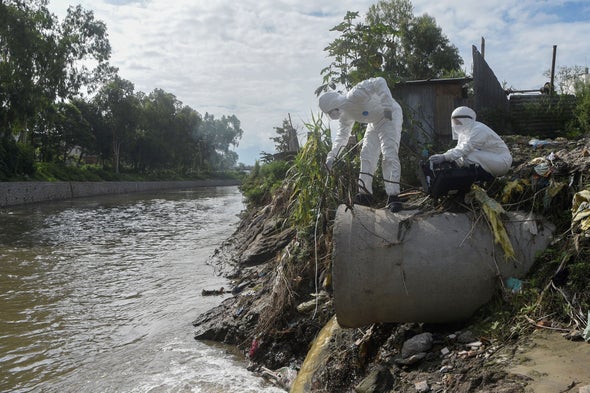
All around the world, sewage gushes out of pipes into rivers and the sea, threatening the health of humans and aquatic ecosystems. Though some individual sites have long been known to be major sources of coastal pollution, “we’ve never had a global understanding of how big the problem is,” says Cascade Tuholske, a geographer at Columbia University’s Earth Institute. He and his colleagues took a broad look at the issue by calculating the amounts of fecal pathogens and nitrogen—which can fuel harmful algal blooms and create oxygen-deprived dead zones—flushed into the ocean in human wastewater at nearly 135,000 sites around the world. They found that they could attribute about half of the nitrogen pollution to just 25 locations and that around half of the pathogens also came from 25 sources, in some cases the same ones.
The researchers say these findings, published this week in PLOS One, could inform international collaborations and help policy makers choose the most effective sewage treatment strategies for contaminated areas.
Many scientists examining human impacts on coastal ecosystems have focused on agricultural runoff, Tuholske says, because fertilizers that wash into the sea carry massive amounts of nutrients and pathogens that can harm marine environments. But the impacts of human sewage receive far less attention, says Joleah Lamb, a marine scientist at the University of California, Irvine, who was not involved in the study. Part of the reason may be that, unlike trash or oil spills, sewage can be invisible in the water. “I’ve been taken to beaches that look beautiful and clean,” Lamb says. “But then we start testing the water, and there are significant levels of human pathogens in the water.”
There are many ways to treat sewage, each with advantages and disadvantages, Tuholske explains. For example, wastewater treatment facilities thoroughly filter pathogens but are less effective at removing nitrogen They are also costly to build, operate and maintain. Septic systems are cheaper and can capture most of the nitrogen, yet they are less effective at preventing pathogens from entering the environment. Identifying places where sewage-borne nitrogen and pathogens are separate or combined problems can help policy makers identify the most effective solutions, Tuholske says.
Seeking to address this information gap, Tuholske and his colleagues analyzed demographic data for urban and rural communities around the world. They also looked at the access those communities had to different types of wastewater treatments, along with national statistics of protein consumption, which helped them calculate how much nitrogen people’s waste would likely contain. The researchers used this information to build a global grid showing where nitrogen and pathogens in sewage were coming from and how that sewage had been treated. They then combined this sewage-source grid with mapped boundaries of watersheds (areas that drain into a body of water such as a river) and with the locations of reefs and seagrass beds that are sensitive to pollution.
The team found that, globally, sewage entering the sea contains about 40 percent as much nitrogen as global agricultural runoff pollution does. This figure indicates that even though sewage is less visible, it contributes a significant amount of nutrient pollution. Moreover the researchers showed that nitrogen from human sewage reaches about 58 percent of the world’s coral reefs and 88 percent of seagrass beds. Both these coastal ecosystems are important wildlife habitats and can help mitigate climate change by sequestering carbon.
Tuholske and his colleagues also found that sewage pollution was a highly concentrated problem. Half of the watersheds analyzed flushed virtually no sewage nitrogen or pathogens into the oceans. Just 25 watersheds—dispersed across nearly every continent and spanning multiple countries—contributed about 46 percent of wastewater nitrogen. The same number of watersheds contributed 51 percent of sewage-borne pathogens in the sea. Top sources of sewage nitrogen included the Yangtze River watershed in China, which contributed 11 percent of the total, the Nile River in northern Africa, the Mississippi River in the U.S., the Paraná River in Argentina and the Danube River in Europe.
Nitrogen and pathogen contributions did not always correlate, the researchers noted. For example, they found that large amounts of sewage pathogens were flushed down the Brahmaputra River in Central and South Asia, but when compared with the Yangtze River, the former’s nitrogen contribution was much lower than expected. Differences in existing sewage treatment practices in the two regions may partially explain this, the team says.
The results of the study are “really exciting because we can start pinpointing where we have sewage nitrogen and pathogens entering the environment,” Lamb says. “That helps conservationists, wastewater managers and sanitation specialists work together to develop these interventions that can mitigate nitrogen or pathogens entering the environment, or both. It teases these problems apart and shows where you will get the most bang for your buck.”
"world" - Google News
November 13, 2021 at 12:56AM
https://ift.tt/3ohEW9e
Half of the World's Coastal Sewage Pollution Flows from Few Dozen Places - Scientific American
"world" - Google News
https://ift.tt/3d80zBJ
https://ift.tt/2WkdbyX
Bagikan Berita Ini














0 Response to "Half of the World's Coastal Sewage Pollution Flows from Few Dozen Places - Scientific American"
Post a Comment